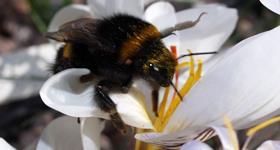
Wild pollinators could be “decimated” by diseased commercially-raised species of bees, a new study by the University of Exeter has found.
Bees, hoverflies and butterflies are at risk from diseases including Deformed Wing Virus, which is spread by the Varroa mite and is one of the main culprits of disease-related losses in commercial honeybee colonies.
Researchers are now calling for new monitoring measures to prevent the introduction of diseased pollinators into natural environments.
“Our study highlights the importance of preventing the release of diseased commercial pollinators into the wild,” said Dr Lena Wilfert from the University of Exeter. “The diseases carried by commercial species affect a wide range of wild pollinators but their spread can be avoided by improved monitoring and management practices.
“Commercial honey bee keepers have a responsibility to protect ecologically and economically important wild pollinator communities from disease.”
Commercial pollination services are primarily provided by honeybees and bumblebees and are typically used to pollinate crops including tomatoes, sweet peppers and oilseed rape, but wild pollinators also play an important role, the study said.
And the social behaviour of honeybees, bumblebees and wasps provides “perfect conditions” for disease transmission both within the colony and between different species.
The risk of disease transmission can be further increased through poor management of commercial species including international transportation of bees without appropriate checks, intensive breeding, poor pathogen screening, and the release of commercial bees into the environment to interact freely with wild pollinators.
Future work will investigate which commercial species is driving disease transmission. The researchers will also monitor the effectiveness of existing conservation schemes to determine their success in protecting wild pollinator populations.
The study was funded by the Royal Society and the Natural Environment Research Council and was published in the Journal of Applied Ecology.



